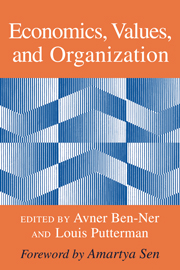Book contents
- Frontmatter
- Contents
- Foreword
- Preface
- List of contributors
- Introduction
- Part I The formation and evolution of social norms and values
- Part II The generation and transmission of values in families and communities
- 6 Did Father know best? Families, markets, and the supply of caring labor
- 7 How communities govern: the structural basis of prosocial norms
- 8 Moral overload and its alleviation
- 9 Moral diversity and specialized values: some observations
- Part III Social norms and culture
- Part IV The organization of work, trust, and incentives
- Part V Markets, values, and welfare
- Epilogue
- Index
9 - Moral diversity and specialized values: some observations
Published online by Cambridge University Press: 05 June 2012
- Frontmatter
- Contents
- Foreword
- Preface
- List of contributors
- Introduction
- Part I The formation and evolution of social norms and values
- Part II The generation and transmission of values in families and communities
- 6 Did Father know best? Families, markets, and the supply of caring labor
- 7 How communities govern: the structural basis of prosocial norms
- 8 Moral overload and its alleviation
- 9 Moral diversity and specialized values: some observations
- Part III Social norms and culture
- Part IV The organization of work, trust, and incentives
- Part V Markets, values, and welfare
- Epilogue
- Index
Summary
It is widely believed that “moral dissonance” results when individuals have preferences over material goods that conflict with the “superior values” inculcated into them by religious or other groups. Instead of delving into this conflict within individuals, one may analyze the conflicts or tensions in a society divided into groups of individuals with sharply differing preferences, as, for example, those primarily motivated by greed and those primarily motivated by superior values. The first approach is pursued by Kuran, the second by Bowles and Gintis, in their respective chapters in this volume. Bowles and Gintis look at the equilibrium properties of societies made up of individuals with and without cooperative traits (“nice” and “nasty”). In their model “agents are paired for trade through some stochastic mechanism.” While there may be diversity in the societies modeled by both Kuran and Bowles and Gintis, there are no religiously, racially, or tribally defined subgroups with special sets of values that are likely to determine the patterns of interaction which will take place in those hypothetical societies. In this note, I focus on groups with specialized values that played a critical role in societies transiting from Gemeinschaft to Gesellschaft.
Some of the groups I am referring to are well known (the Jews in early modern Europe, the Chinese in Thailand, the Asians in East Africa, the Armenians in Turkey), others less (the Bamileke tribe in Cameroon, the Parsis in India, the Berbers in Morocco).
- Type
- Chapter
- Information
- Economics, Values, and Organization , pp. 267 - 272Publisher: Cambridge University PressPrint publication year: 1998



